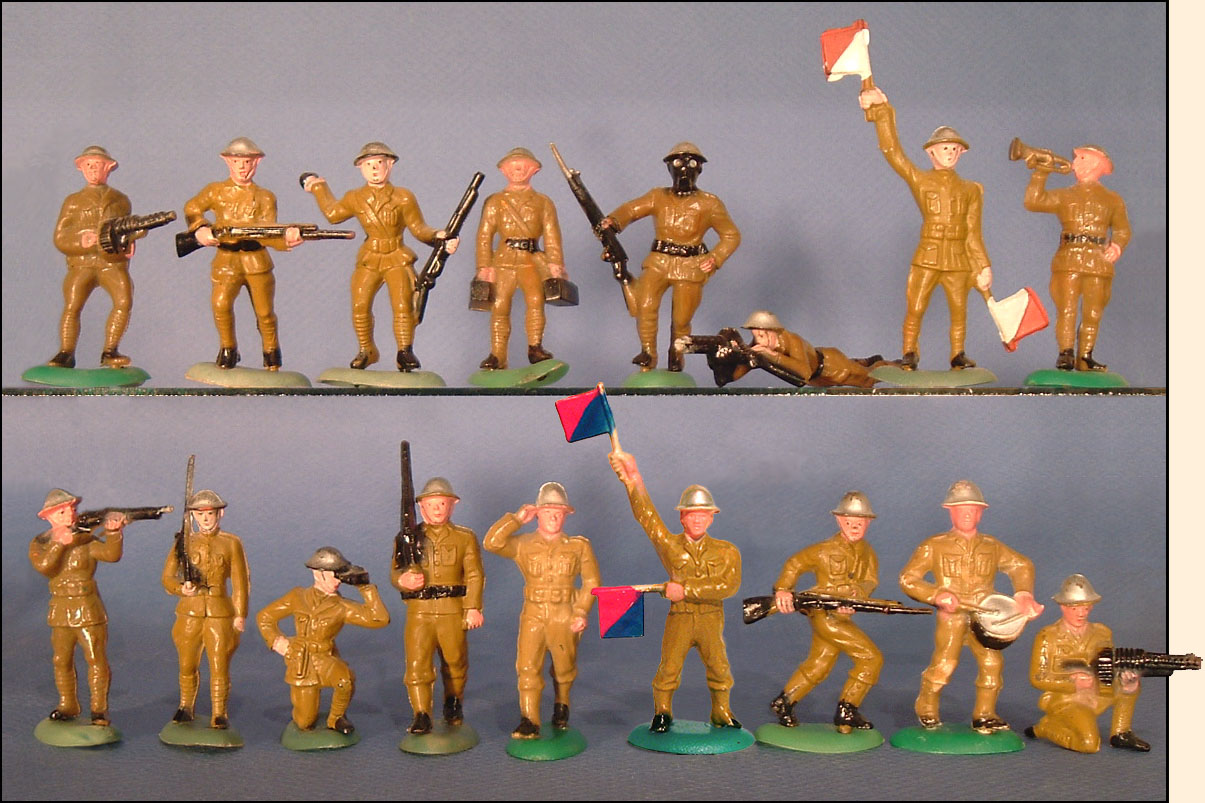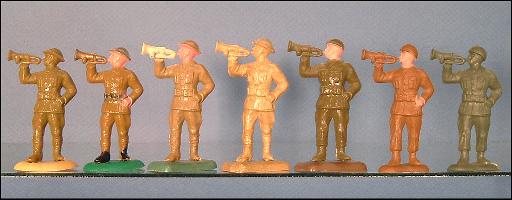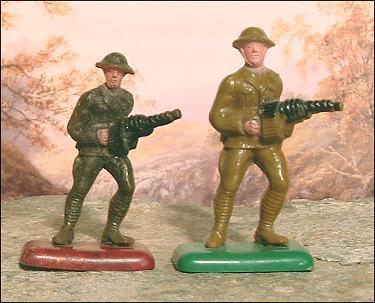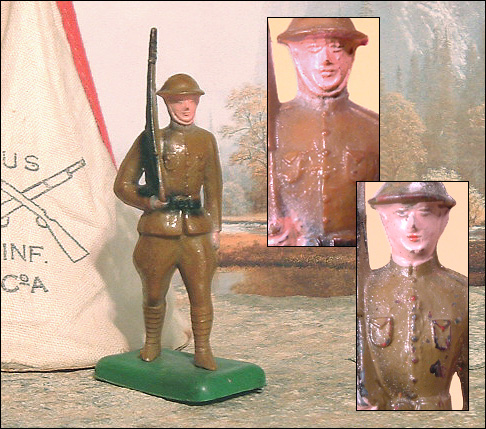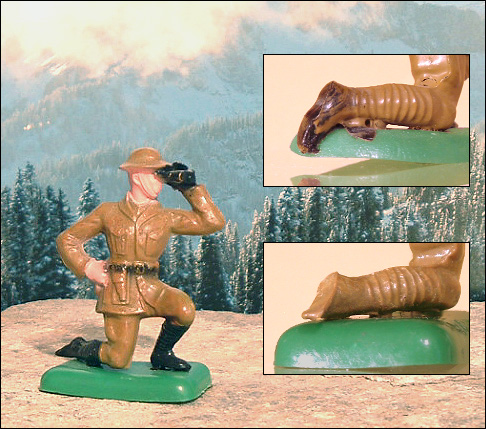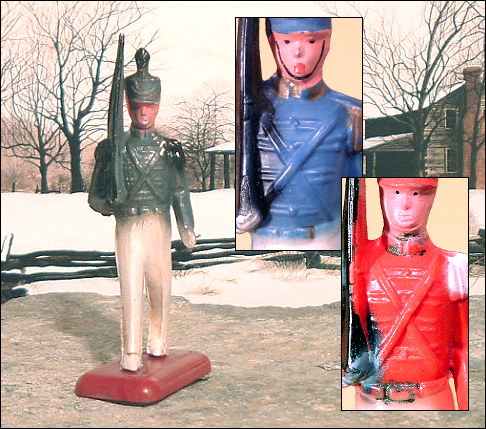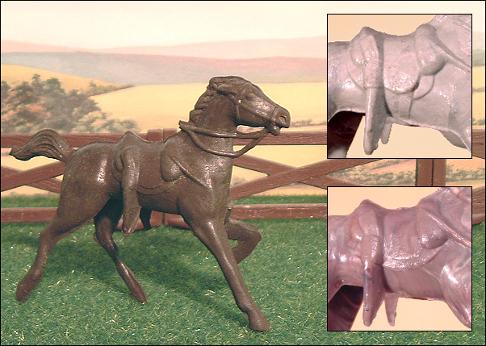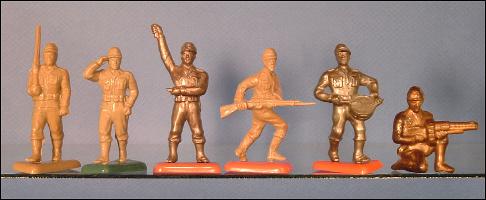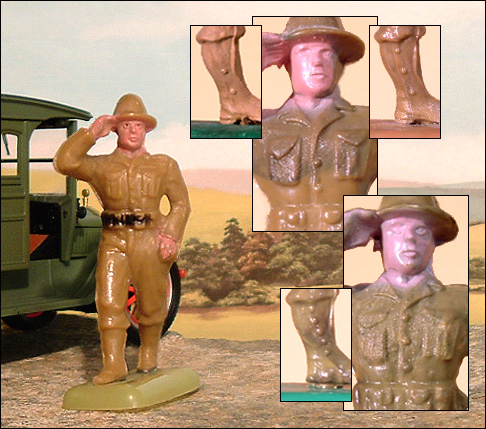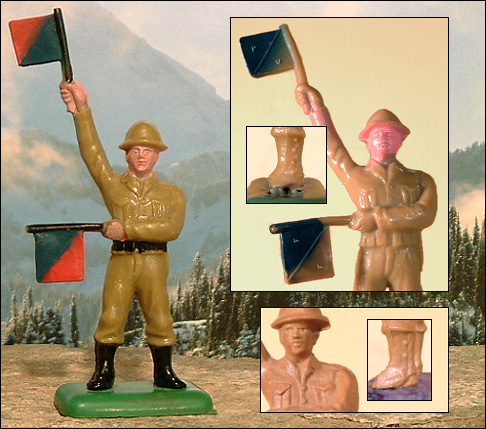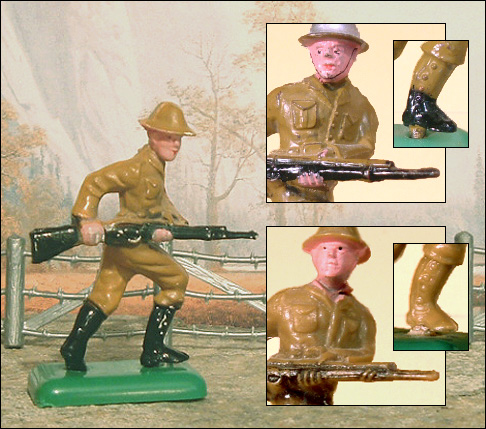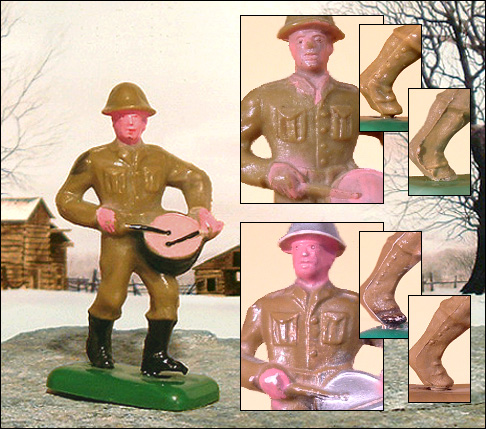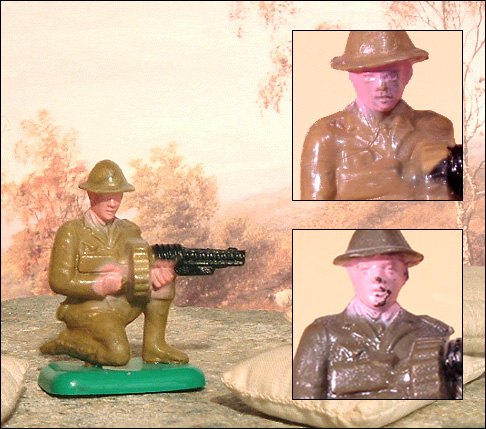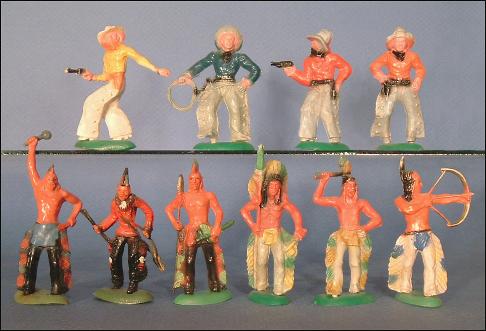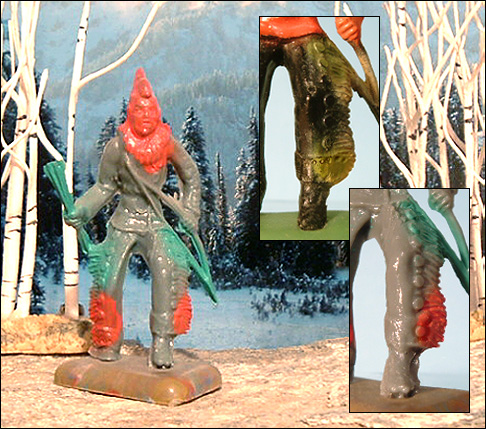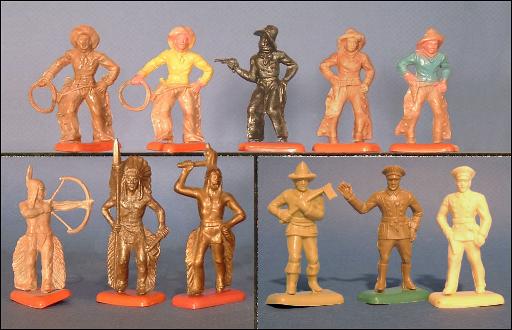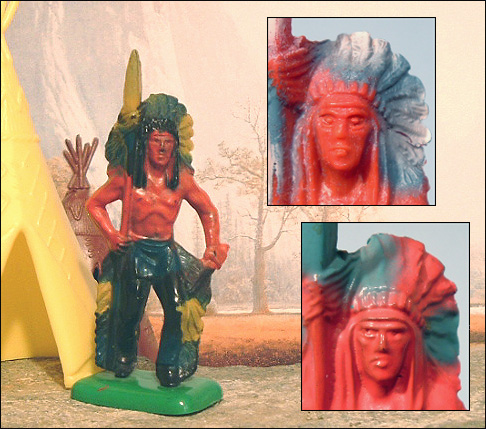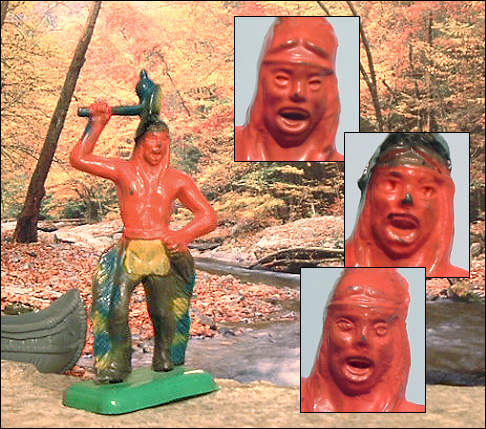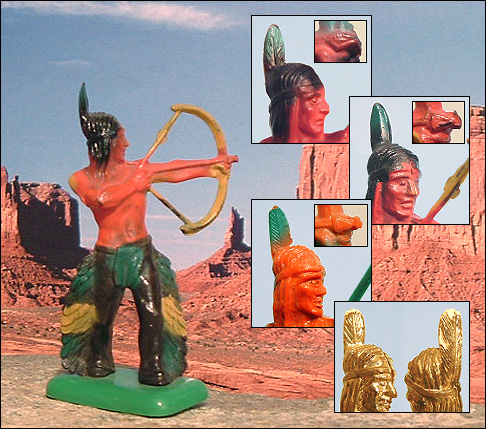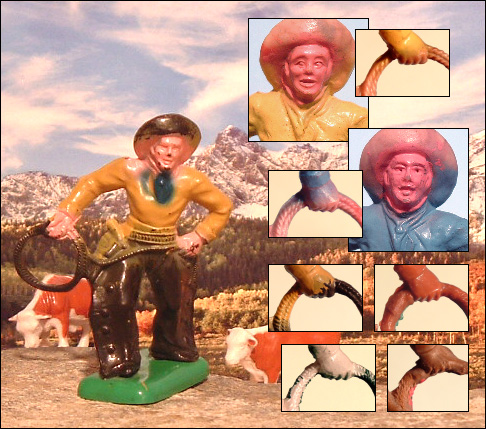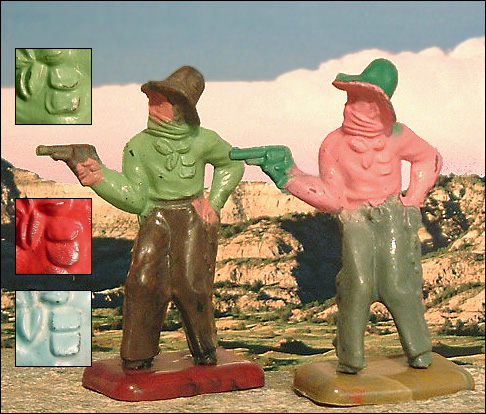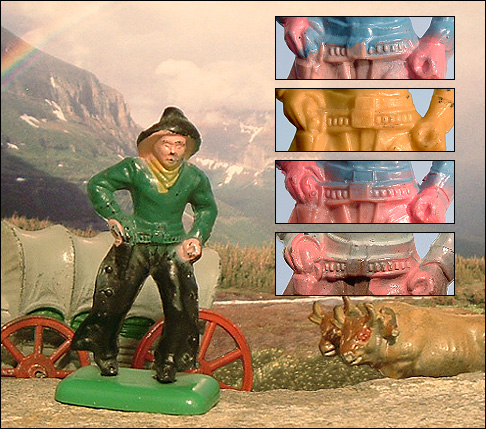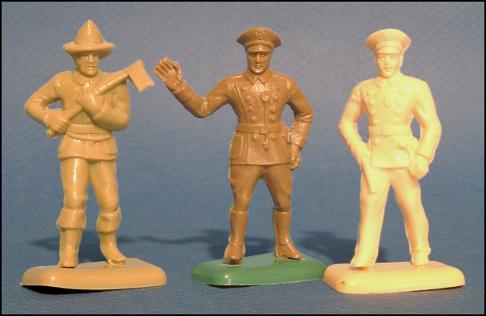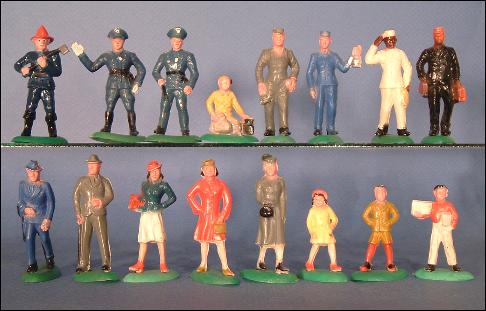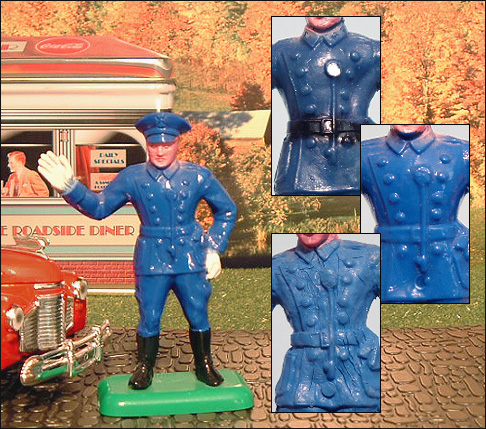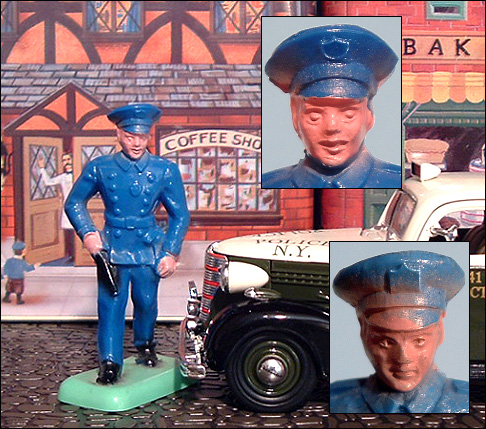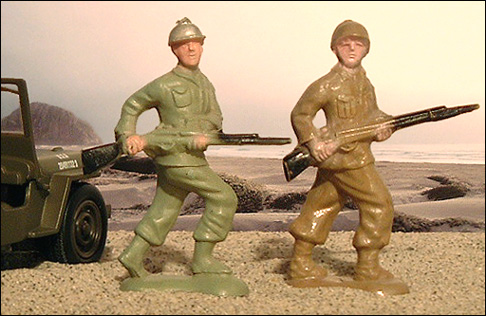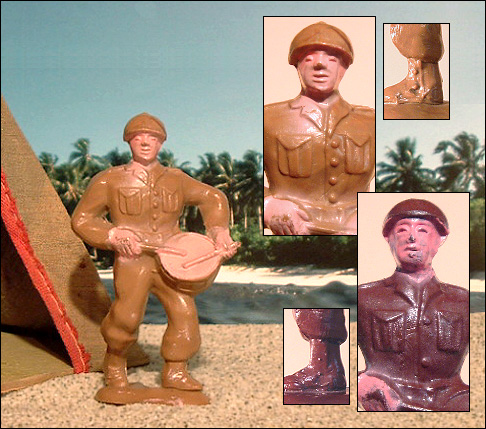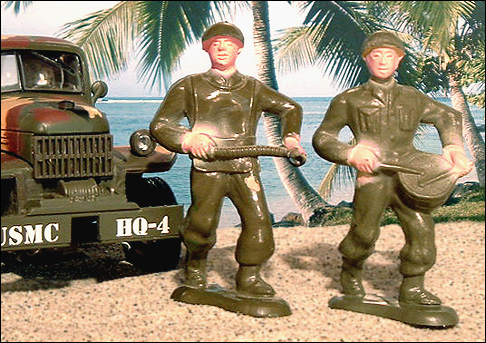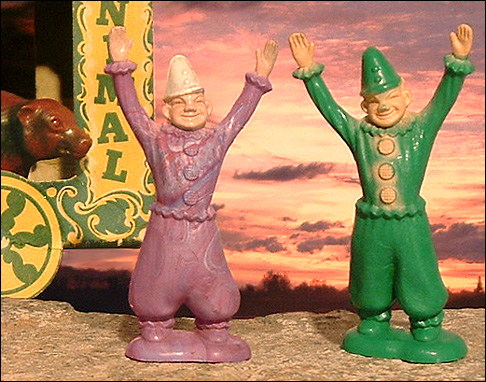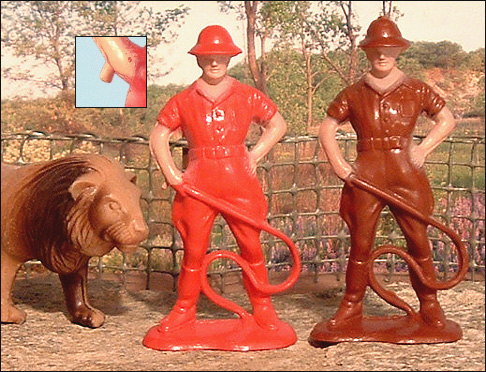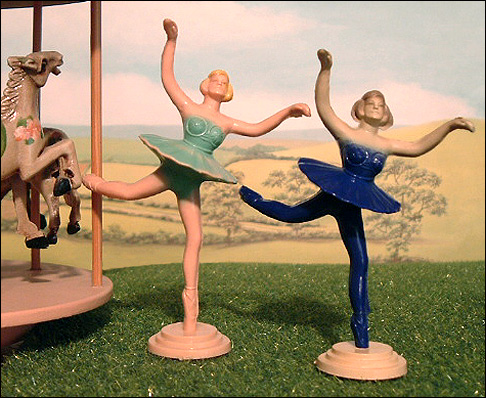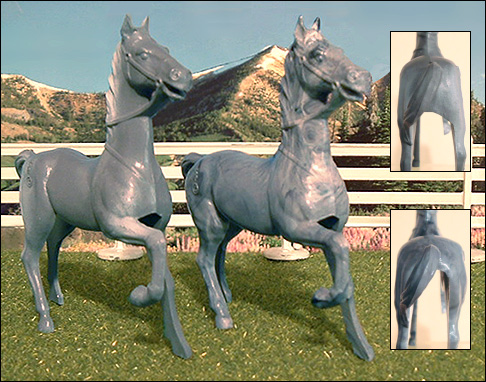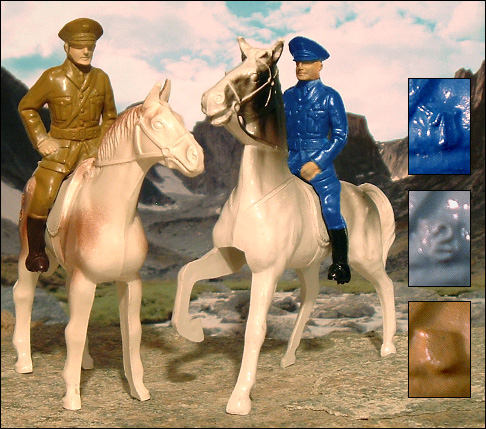|
|
||||||||||||||||||||
 |
Bergen Toy & Novelty Company |
by Ron SteinerI was only nine or ten years old when I discovered my first Beton variation. I'd bought a new Highwayman at Woolworth's and found that it didn't exactly match one that I had previously acquired. It seemed to have kind of a sissy stance. The right knee was turned inward, making him knock-kneed, and of course that didn't make for a very formidable cowboy. When my buddy and I played cowboys and Indians with our Betons, this guy was always the first to get shot, and he finally met his demise by being thoroughly chewed up by my dog! At about that same time, I found that I had a Cowboy with Lasso that had UP under the base instead of BETON. When I began collecting Dimestore Toy Soldiers in the early 1980s, my interest in casting variations grew. Beton SoldiersBergen Toy & Novelty Company (often abbreviated as Beton) incorporated a large number of variations when casting their line of plastic toy soldiers. But surprisingly, Beton can't take all the credit for the majority of these variations. Beton acquired molds from Universal Plastics sometime in mid-1940, and these 1939 Universal figures contain many more variations than the ones Beton originally produced. Beton "chased" the molds of the soldiers to replace Universal's soft caps with Beton's helmets, and incorporated the new figures into their line of toys by Christmas of 1940. The addition of Universal's figures increased Beton's line by at least 14 figures.
[For a larger version of the photo above, click here.] As most Beton collectors know, Betons went through several transitions. From 1938 through 1941, the company used an oval base that was prone to warping. In late 1941, they started using Universal's rectangular base with the addition of a cross-brace chased into the molds to help alleviate any warping. Some early soldiers have turned up unpainted, but most had painted khaki uniforms. This was discontinued about 1942, and from then on the soldiers were cast in khaki-colored plastic. During most of WWII, the figures were no longer detail painted at all. Around 1946, most of the soldier line was redesigned using WWII pot helmets and bloused trousers instead of leggings. Interestingly, not one of the original Universal soldiers went through this design change. In 1949, the soldiers were again redesigned, and integral cast bases were introduced. The early 1950s saw the addition of new soldiers, large riders, and farm and circus figures. In the last few years before Beton went out of business, in 1958, they produced their figures in soft plastic.
Some collectors believe that Beton originally cast its figures in a larger and a smaller size. I don't buy into this theory! I believe that Beton contaminated its batches of plastic by throwing in the scrap flashing, sprues, etc., causing the contaminated castings to shrink, crack, and generally deteriorate at a later date.
Original Beton VariationsIn Beton's original line of 18 soldiers, including the Cadet and the small military riders on trotting horses, I've found only four figures with casting variations. Catalogue #510 Rifleman, Marching Position, has three variations. One figure has six tunic buttons and a helmet chin strap, the second has seven buttons but comes both with and without the chin strap. The one without the strap is hardest to find, but all three variations are found in the earliest 1938 examples.
Catalogue #511 Infantryman with Field Glasses has two variations. The first's right shoe has a full heel and sole, while the second's is missing, leaving a concave sole. The early observers with oval bases all seem to have the full shoe. The vast majority of the rectangular-based and all of the cast-based observers have the concave shoe. I've only found a full shoe on one very early rectangular-based observer with painted uniform, which leads me to believe that when a new mold was made, in late 1941 or early 1942, a damaged master figure was used to make it.
Catalogue #620-625 Cadets came in six basic color variations, but they also included two minor casting variations. The braid on the chest of one is closely spaced, with the three buttons sitting on the braid. The other has wider spaced braid, with the buttons placed between.
The fourth variation concerns the early version Trotting Horse, which seems never to have received an individual catalogue number. The more common 1941 version Running Horse was given Catalogue #1000. The two casting variations found for this early Running Horse are that one has a saddle with girth running under its belly while the other has no girth.
Universal Plastics / Beton VariationsThe soldiers that originated with Universal Plastics contain the majority of the casting variations in the Beton line. Beton gave these soldiers Catalogue numbers 512 through 517. the only soldier that I've been unable to find a variation on is #512 Rifleman, Marching Position. Most all of the Universals can be distinguished by the varied details chased into their molds. Eyes, mouths, buttons, and sometimes the sprue locations can be noted. I also collect Universal Plastics figures, but, in some cases, I can't verify that all variations date back to an original Universal mold.
[For a larger version of the photo above, click here.] Catalogue #513 Infantryman, Saluting, has two variations, but the first has a subvariation. All three sprues are in the same location. The first variation is the only example I've found on both the Universal and the Beton figure, and it has two legging buttons on the right leg, two tunic buttons, and pupil eyes. Its subvariation has gained a third, top, button on the right leg. The second variation has five legging buttons on the right leg, three tunic buttons, and a slightly bug-eyed left eye.
Catalogue #514 Signaller has three variations, and, again, the sprue locations are the same. The first two are almost exactly alike, except that on one, the flags have the embossedletters PU and FF, possibly standing for "Universal Plastics" and the sculptor's initials. Surprisingly, the letters continued on the flags through the 1950s cast-base versions. The second variation has flags without letters. Both of these have bug-eyes and four buttons on the left legging. My only example of a Universal Signaller has no flags (they've been broken off), but it does have bug-eyes and four buttons. The third variation also is missing letters on the flags, but it has pupils and only two buttons on the left legging. Also, the mouth appears slightly different.
Catalogue #515 Infantryman, Charging, has only two variations, the most prominent being the bayonet clasp. On one variation, the clasp is vertical, the tunic has three buttons, the left legging has five buttons, and the figure is bug-eyed. With the second, the clasp is on an angle, there are no buttons on the tunic, there are only four left legging buttons, and it has eyelids. Again, the mouth is slightly different, but the sprues are in the same location.
Catalogue #516 Drummer has two main variations, and each has a subvariation. I've found only one Universal that falls into the first variation. This one has bug-eyes, four buttons on the tunic, sprue located on his rear, and four buttons on the right legging. This one's subvariation has lost all four buttons on the legging. The next variation has pupils, only two tunic buttons, sprue located on the waist in back, and also four buttons on the right legging. Its subvariation has lost one button on that legging. Once again there is a slight difference in the two mouths.
Catalogue #517 Machine Gunner, Kneeling. This figure was produced with and without the separate bases, and the only Universals that I have are without the base. There are only two very slight variations. The first, including my Universals, has pupils and a tunic breast pocket. The second has eyelids and a flap on the breast pocket. Both sprues are in the same location.
Base MarkingsOne last bit of information concerning Beton variations should be noted. Beton's original oval bases were unmarked, then later were marked Carlstadt N.J. Both versions had left and right variations. When they revamped Universal's rectangular base with a cross-brace, the original embossed UP symbol was still slightly visible beneath the chased brace. For a short time, the new bases were unmarked. Later an embossed BETON was added. I've been able to detect 11 different locations for the UP symbol in comparison to the brace. Apparently, they chased several for a sprue tree. The UP symbol was eliminated on the postwar rectangular bases. Beton Cowboys and IndiansWorld War II ended in 1946, and my interest in soldiers soon waned. I began seeing more cowboys and Indians in Woolworth's toy bins, and the Betons, as always, caught my eye. Plus, they were being painted again. Maybe they were not as detailed as the prewar figures, but they were certainly more colorful than the drab, unpainted grays, browns and blacks that didn't excite me much during the war years.
[For a larger version of the photo above, click here.] Beton used catalogue numbers 726 through 730 for their six Indians. The first three were patterned after Eastern Woodland Indians and were original to the Beton line. The next three were added to the line with the 1940 acquisition of Universal Plastics' molds and appear to represent Western Plains Indians. The catalogue numbers for the four cowboys were 830 through 833, and only the first one, Masked Bandit, originated with Beton — the other three were originally from Universal. I've found only one casting variation on a Beton-originated cowboy or Indian. Catalogue #727 Indian with Arrow has two variations. The first variation has six buttons down each leg, and both pant cuffs are decorated with eyelets. With the second variation, the left cuff has lost its decorations, and a seventh button has been added on that cuff. I've never found this second variation on an early oval-based #727, but it's the only one that was incorporated in the 1950s cast-based version.
All six of the cowboys and Indians originating with Universal Plastics are loaded with variations. Some variations began with Universal, then Beton apparently detail-chased some of the molds that they made at a later date, creating many more variations. As with the soldiers, there are bugged eyes and eyes with pupils, along with different sprue locations. Beton also added more subtle variations, such as the texture of feathers on the Indians and the number of bullets in a cowboy's belt. It gets pretty complicated and hard to determine which variations might be a subvariation instead. Collectors had always believed that Universal Plastics never painted any of their figures, but in December of 2005, I was surprised to find five Universal cowboys with painted flesh and shirts in four different colors. It is unknown whether these were actually painted by Universal or whether Beton acquired these figures along with the molds and painted them at a later date.
[For a larger version of the photo above, click here.] Catalogue #729 Indian Chief has two basic variations, but the second variation has four very subtle subvariations. The first has distinct bug-eyes, finely detailed feathers in the headdress and on the pant legs, and sprue is located on the back belt line. This variation is found on both Universals and Betons. The second variation has pupils in the eyes, crude or nondetailed feathered headdress and pants, and sprue located much lower on his rear. So far, this variation has been found only on Universals. This one's first subvariation appears on Universals and quite extensively on Betons and is strictly a location change of the sprue to just below the back belt line. The next three subvariations appear to be Beton variations that took place after they acquired Universal's molds. The second subvariation again changes the sprue to the belt line, but it retains the pupils and crude feathers. The third subvariation also retains the pupils and the crude feathers in the headdress, but Beton has chased finely detailed feathers on the pant legs and relocated the sprue lower on the rear. The fourth subvariation has different detailed feathers on the pant legs, additional finely detailed feathers on the headdress, and again, the sprue has been relocated to the belt line. Since the subvariations are generally so minor or repetitive, I've illustrated the two basic variations only.
Catalogue #730 Indian Warrior has three variations, and the first two originated with Universal Plastics. All three have the sprues located on the back belt line. The first variation has nicely shaped eyelids, with eyeballs showing beneath, and a mouth with upper teeth and a tongue, plus the right edge of the back loincloth is curved at the top. The second variation has pupils in the eyes, upper teeth but no tongue, and a back loincloth that is straight on the right side. The third variation probably originated with Beton; it has poorly detailed eyelids, upper teeth along with a tongue, and a straight-edged loincloth that's in line with the center of the sprue.
Catalogue #731 Indian with Drawn Bow has two variations that originated with Universal Plastics, one that originated with Beton, and a subvariation added to the Beton variation. All four have bug-eyes and sprues located on the back belt. The first variation has soft facial features, a finely detailed feather treatment in the hair, and fine detailing on the pants, plus the arrowhead is diamond shaped. The second has a plain, undetailed hair feather, a cruder treatment on the pants, and a triangular arrowhead. Variation #3 has detail added to the front of the hair feather, and the face has a hawkish appearance, but all else appears to be the same. The subvariation to this has slightly different detail to the feather's front and also includes detailing on the back of that feather. I've only found this subvariation on a late-1950s electroplated Indian.
Catalogue #831 Cowboy with Lasso also has two variations that originated with Universal Plastics. The first one seems to have disappeared around the time of the early transition from oval to rectangular bases, and the second sprouted a subvariation at about that same time. In addition, Beton produced three more variations. The first variation has slightly bulging eyeballs, a nicely detailed double strand of rope, and sprue on his right rear. The second has pupils in the eyes, a smiling mouth, a button on his neckerchief; the rope is almost exactly the same, and the sprue has moved to the back belt line. Subvariation #1 to this is exactly the same, except the sprue is below the cartridge belt. All of the next three Beton variations have pupils and the smiling mouth. The third variation has lost a substantial amount of detail on the rope's back and has a completely new treatment chased into the front of the rope, plus the sprue is again located on the back belt. The fourth has new detail chased into both the front and back of the rope, and the sprue is below the cartridge belt. I've only found one example of the fifth variation, and, unfortunately, the rope is broken off. It does appear to have another new rope treatment but, more important, the sprue is located on his belt buckle.
Catalogue #832 Highwayman has four variations. The first has a breast pocket with ribbed edges, and the sprue is located on the right rear. With the second variation, the pocket has lost its ribbed edge. The third shows a squarer pocket, the neckerchief is slightly different, and the sprue is relocated to the right belt line on the back. The original Universal Plastics highwayman, along with these first three variations, had the right knee in line with the figure's body. Beton's fourth and most dramatic variation took place around 1945. Possibly because of a badly repaired master, the fourth variation's right leg was turned inward, giving him an awkward, knock-kneed stance. The sprue is located at the belt buckle. Both the "knee-out: and "knee-in" variations continued through the 1950s cast-based highwaymen.
Catalogue #833 Cowboy, Hand on Holster, also has four variations. The first three originated with Universal, and the fourth with Beton at a later date. Variation #1 is noted for having only three bullets in the cartridge belt on his right side, an indistinct hip pocket, and sprue located on his right rear. The second variation has four bullets on his right side and a ribbed hip pocket, and the sprue has moved to his rear belt line. Beton created a subvariation of this by relocating the sprue to the belt buckle. The third Universal variation is so subtle that it's easily missed. The first of the four bullets has shifted upward and the belt buckle has ribbed edges, but all else appears the same. This variation also spawned another Beton subvariation that relocates the sprue to the cartridge belt buckle. Beton's fourth variation simply added a seventh bullet to his left side and placed the sprue on his rear.
Beton CiviliansI never discovered Beton's civilians as a kid, which was a real shame. They would have peopled my Lionel train layout much better than the out-of-scale Barclay and Manoil metal figures that I used. When the information about Universal Plastics surfaced in 1993, I had been corresponding with Richard O'Brien. He sent me a copy of the 1939 article in Modern Plastics magazine that stated that "Universal Plastics Corp. was experimenting with a line of molded plastic soldiers, Indians and such." Richard had always wondered why so many of the figures in Beton's line, such as the Signallers, were so similar. He theorized that some civilians might have originated with Universal also. I went on a civilian-buying quest to either prove or disprove his theory, but the only two civilians that I subsequently found with UP bases were catalogue #901 Fireman and #907 Traffic Officer.
Knowing that the Universal soldiers, cowboys, and Indians contained more variations than the original Betons led me to thoroughly scrutinize all the civilians I could find. Surprisingly, the only two figures with variations turned out to be the two policemen. Now the question is, could both cops possibly have originated with Universal? My study leads me to believe that all of the other civilians were Beton originals, but there's always that chance that one will turn up with a UP base some day. [Note: Richard O'Brien's article on Universal Plastics appeared in Old Toy Soldier magazine, Volume 18, Number 5 (Oct.-Nov. 1994), page 20.] December 2007 update: My latest find on eBay is a Universal Patrolman, Beton's catalogue #908. I wasn't surprised by this new Universal figure. After my variations study, I felt there was a good possibility that the patrolman had originated with Universal.
[For a larger version of the photo above, click here.] Catalogue #907 Traffic Officer has three variations, and the first two are found on Universals. The first has a ridged lanyard ring and belt buckle, and the sprue is on his rear. The second has lost the ridges in both areas, and the sprue is located just below the whistle. On the third variation, the ridges are on the buckle only, but the sprue remains below the whistle.
Catalogue #908 Patrolman has only two Beton variations. The first of these has bug-eyes and a small, shield-shaped cap badge. The second variation has pupils and a full cap badge. Both sprues are in the same location, on the back belt. December 2007 update: The newly found Universal Patrolman has bug-eyes and a small, shield-shaped cap badge, as in the first Beton variation.
Later Soldier DesignsAfter World War II, Beton didn't produce as many casting variations as in their earlier years. By 1946, they had begun redesigning most of their original soldier line with more up-to-date WWII uniforms. These still retained the separate, rectangular bases and were produced for only three years. I've never been able to verify whether #506 Machine Gunner in Prone Position was redesigned at this stage or in 1949. None of these transition soldiers, nor the new Cadet, seems to have had any variations. Because of the short production span, these figures are fairly scarce, so I've never amassed a very large study group. In 1949, Beton began a whole new redesign of the soldiers, using an integrated cast-on base. The 1946 pot helmets were slightly changed, and the trousers were bloused a little more, but the redesigned soldiers remained basically the same as the transition pieces. Cowboys and Indians and civilians with their own cast bases soon followed. With the cowboys & Indians, several of the original variations continued showing up. The civilians continued without variations, although the Shoe Shine Boy, Secretary, and Newsboy received improved facial features. The only two new soldiers with variations are Infantry with Bayonet, Charging, and Drummer. Catalogue #515 Infantry with Bayonet, Charging, can't really be considered as having variations, because the two versions are completely different figures using the same basic pose. The first figure is patterned after the original #515 with the separate base, while the second was completely redesigned with his left heel down, his rifle on a bit of an angle, and a much more authentic-looking pot helmet. Surprisingly, this second soldier turned up in an earlier catalogue than the one patterned after the original soldier.
Catalogue #516 Drummer has two variations. Variation #1 has heavy upper eyelids. The tunic has four buttons and there are two buttons on his left legging. The second variation's heavy eyelids are different, and they give him an almost Oriental look. There are only two buttons on the tunic and three tiny buttons on the left legging.
Another soldier that deserves a mention here is the Flame Thrower. Although this is not a true variation, this figure is a modified Drummer. The pose is the same, but the soldier has a protective vest over his tunic, a flame thrower has replaced the drum, and the face is slightly different.
Beton's Sunset YearsBy the 1950s, I had put my childhood toys behind me and had begun pursuing more adult pastimes. At a younger age, I would have been excited by the explosion of new figures and playsets that were coming out of the Bergen factory in the 1950s — additional soldiers, farm and circus people, animals, and both small and large riders with horses. Very few of these Betons had variations. I've not been able to find a variation in any of the farm figures or circus animals, but three of the circus people have slight variations. I've found only one of the large riders and one of the large horses to have variations. Beton's Circus Clown has two variations. In one, the legs are considerably larger and "bloated" looking. When I first encountered these two versions, I assumed that the bloated legs were due to distortion from a bad batch of plastic. I've since found enough examples to lead me to believe these were true variations. Both clowns have also turned up in boxed sets.
The Circus Trainer has three very minor variations. The first has a piece of plastic projecting from the figure's right hand. I'm not sure what this might represent, if anything, but it's exactly the same on many figures. There are sprues on both heels and I suppose this projection could be an additional sprue. The second variation has lost the projection entirely, has the same heel sprues, and there is an added sprue on the back of his neck. Both of these variations are found in boxed sets. The third variation does not have either the projection or the neck sprue but retains the heel sprues.
Catalogue #Z-5 Dancing Girl has two minor variations. The first figure has a sprue located on her right thigh. The second has none, but, more important, the peg that holds the figure in its stand is thinner, causing a very loose fit. I've noticed that the loose-fitting girls all have a different painting technique. Instead of the normal painted tutu and hair on flesh colored plastic, these "loose" girls have their shoulders, arms, face, and hair painted over brightly colored plastic. The legs were left unpainted.
The most surprising discovery for me was Catalogue #4000 Prancing Horse, large, no saddle. As scarce as this horse is, I never expected that Beton would have produced two major variations. The more common prancing horse is sleek, with the rear part of the body cavity well below the horse's tail. It probably wasn't meant for the large riders, since none of them can stay seated on this horse because it's too thin. The other variation has a fat belly that none of the riders can straddle. The rear part of the cavity is high up under the tail.
Catalogue #M4031 Cavalry Officer and #M4032 Police, mounted, large are actually the same figure painted in appropriate khaki or blue. This figure has three variations that all pertain to the shield badge on his chest. There is a Badge #1, Badge #2 and a blank, unnumbered badge.
A Final WordI've intentionally left out some of the extremely minor variations that I've found on a few Betons. These cover slightly different placement of the Bergen Toy & Novelty embossed lettering, plus the occasional embossing of a casting number on a figure. None of these affect a figure's overall appearance. I've also refrained from commenting on size differences, because the purity of the plastic used can affect the finished size of a figure. Also, when a casting was removed from the mold, sometimes a figure received a slight twist or bend that can fool you into thinking it might be a casting variation. That covers the variations that I've found in the Beton line of Dimestore toy figures. If there are any eagle-eyed collectors out there that have found additional variations, I'd be happy to hear from you. I hope I've been able to educate you, and more important, to entertain you! Copyright 2007 Ron Steiner
Vintage Toy Horses and Plastic Playset Miscellany from the 1950s On . . .
|
| [HOME] [ABOUT] [HOW TO ORDER] [BETON/BERGEN] [BETON WWI] [BETON WWII] [*Beton Variations] [*Ron Steiner] [*Beton Sets] [*Pirated Betons] [*A Skirmish] [MARX] [*A Farm] [STUART] [ANCHOR BUGGY] [TIM-MEE] [MISCELLANY] |
